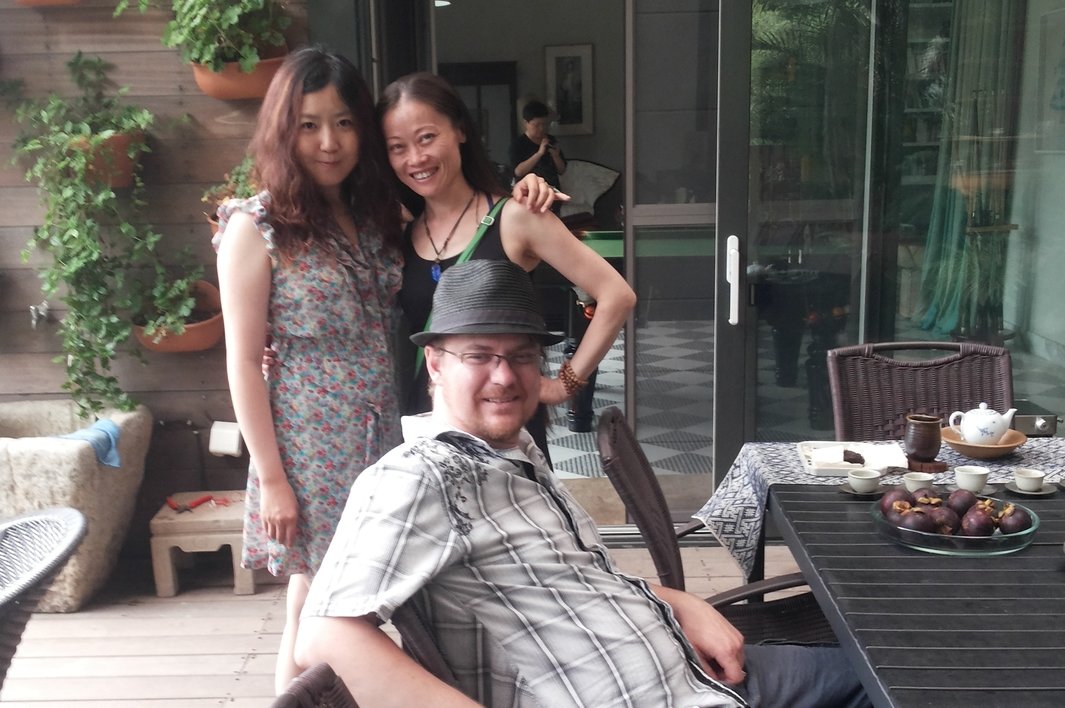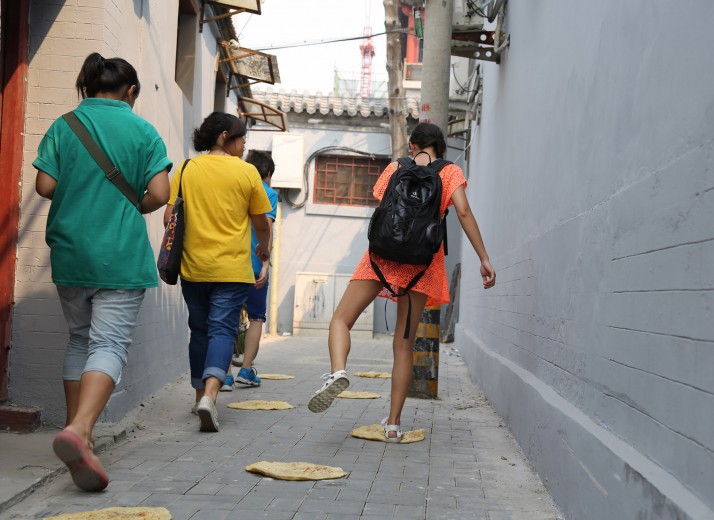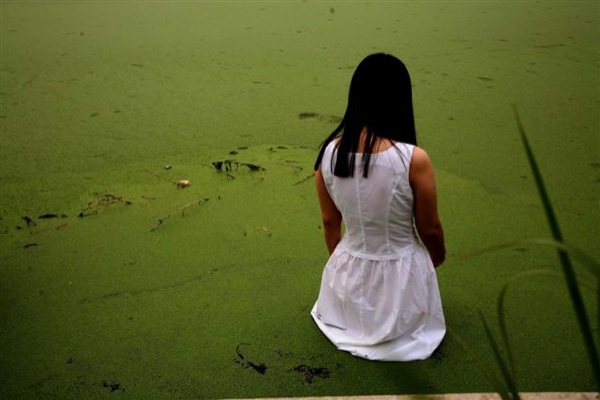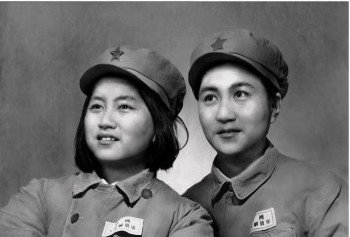Intimate yet universal: Chinese women’s experiences artistically explored at Contact 2014
Through the Body: Lens Based Works by Chinese Women Artists is an exhibition which sets as its premise the Chinese concept of Ti Shi, learning through bodily experiences, and in this case particularly those of women with lived experience in China. Following a guided tour and discussions with the curators Zhou Yan, Matthew Brower and Fu Xiaodong, several insights into this show and its importance came to light.
 Curators (from left) Fu Xiaodong, Zhou Yan and Matthew Brower at Lin Tianmiaos Garden
Curators (from left) Fu Xiaodong, Zhou Yan and Matthew Brower at Lin Tianmiaos Garden
Whilst surveying a specific cultural milieu (young, women, Chinese artists), the curators carefully chose works for the show that could transcend cultural boundaries. The work of Ye Funa, for instance, in which she recreated old family photographs with the family member lip synching a narrative to the photo, resonates across audiences as we can all reflect on our own family histories. In comparing the show to other exhibitions in the Contact festival, Brower pointed out the similarities of Ye Funa’s work and that of Adad Hannah’s, who traced his family tree across generations and places. Both artists seek to form a line of communication between generations, a real riddle in many cultures in our fast-changing world. This comparison across cultures is felt in almost every work of this show, as artists confront us with their experiences through personal and universal journeys of shame, loneliness, love, loss and searching for an identity in a fast changing world.
Yet they also tell diverse stories of life lived in the transitional China of today. Zhou describes the specific cultural references of several works along the way. Fang Lu’s work explores how art is like love in that both are transformative experiences. In Fang Lu’s performance video, artist Guan Xiao is buying food at a typical market and then playing hopscotch on pancakes. In doing so, she has depicted traces of common Chinese life, including traditional hutong houses which are fast disappearing and pancake streetfood which remain popular and accessible on many street corners.
 Fang Lu, Lovers Are Artists (Part 1), video still, 2012
Fang Lu, Lovers Are Artists (Part 1), video still, 2012
Another artist, Jin Hua, emigrated to study and live in Canada. Upon the death of her mother she returned to China to reconnect with her parents’ family. She took photos of what is really happening in China, showing the clash of tradition and change in simple household goods and family pastimes. The curators have selected works which, whilst not attempting to define China, provide a window onto the diversity and complexity of contemporary Chinese women’s’ lives.
 Li Xinmo, The Death of the Xinkai River, 2008
Li Xinmo, The Death of the Xinkai River, 2008
As curator Matthew Brower pointed out, these lens-based artists employ allegory as their choice method for presentation. Allegory has a long and popular tradition in Chinese art. Li Xinmo, for instance, shows herself entering the highly aesthetic green but polluted, dying lake. Zhou explains that behind this image is the specific story of paying tribute to the death of a murdered woman, rebelling against the suffering and unfairness of a woman’s life. All of the artists in this show use their story-telling method both fluidly and poetically, enriching each piece with such multiple layers of meaning.
 Chen Zhe, The Bearable: Birthday, 2010
Chen Zhe, The Bearable: Birthday, 2010
Several works in the show confront the audience with images of intense and painful bodily experience. Ma Quisha gives a monologue about how her parents sacrificed for her to be what they wanted first, a musician, and later sacrificed even more for what she wanted to be, an artist. She is speaking with a razor blade in her mouth, swallowing blood, only noticed when she removes the blade towards the conclusion and by close observation of the pink of her teeth. The video is dedicated to her parents, showing the complicated dynamics of parent-child relationship in today’s Chinese families. In another striking series, Chen Zhe depicts herself cutting her own arm, a painful practice, that many others share. She is very brave in her way of facing self-harm and sharing the truth with the world. Fu explains how, due to the relative upheaval in China over the past few decades, many Chinese artists tend to express themselves in a more intense and sometimes violent manner than artists in the west.
 Ladybird Theatre, Riding a Roller Coaster Flying into the Future , video still, 2013
Ladybird Theatre, Riding a Roller Coaster Flying into the Future , video still, 2013
Several of the artists participating in the show define themselves as feminist, including Li Xinmo and Ladybird theatre. Ladybird theatre enacts poetry written by women exploring gender relationships in themes such as child prostitution, women as objects, rape and labour. Bower describes how this piece was inspired by the scandal of a young, female poet who had an affair with an older married poet but found all the pressure and criticism came in only her direction, eventually leading to her suicide. Zhou and Fu note that other works in the show, such as those by Fan Xi, Chen Zhen and Chun Hua Catherine Dong explore feminism in territories similar to thinkers like Judith Butler and Susan Sontag. They go on to say that feminism as a movement has not successfully rooted in China. However, they believe that it is a topic that still needs to be faced.
The curators have seamlessly brought together a group of talented artists in a tightly woven tapestry of personal experiences derived from life lived as women in China today. Juxtaposed to other recent exhibitions of art from China, this is an important show which will give audiences in Toronto a much more detailed and complex vision of what artists are producing in relation to contemporary Chinese experience. Moreover, it is a poetic and powerful show that crosses cultural boundaries and will resonate with many audiences.
Christine Platt
assistant: Liuyi Zhang
*Exhibition information: April 29 – June 28, 2014, University of Toronto Art Centre,15 King’s College Circle, Toronto. Gallery hours: Tue–Fri, 12 – 5, Wed, 12– 8, Sat, 12 – 4 p.m.

